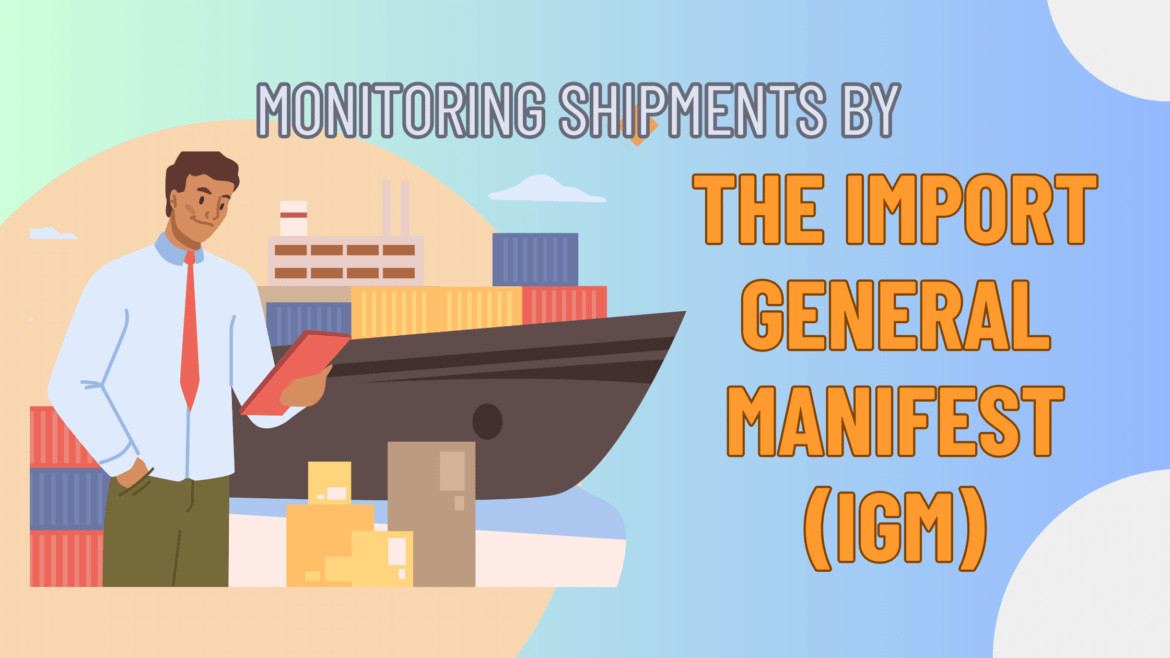It is crucial to remain aware and in charge of your cargo in the ever-changing world of international trade and shipping. One important document that is essential to accomplishing this is the Import General Manifest (IGM). It serves as your compass in the wide world of logistics, helping you to navigate the challenges of keeping an eye on your shipments. We’ll go into the world of IGM in this post and see how it makes shipment tracking easier.
Understanding the Import General Manifest (IGM)
One important document used in international transportation is the Import General Manifest, or IGM as it is frequently called. Shipping lines or their representatives file it with the importing nation’s customs authority. The Import General Manifest (IGM) is a crucial tool for cargo tracking, customs clearance, and shipment monitoring since it includes detailed information on every shipment of cargo that arrives on a vessel.
The Role of IGM in Shipment Monitoring
The foundation of cargo monitoring is IGM. It makes it possible for freight forwarders, importers, exporters, and customs officials to closely monitor cargo movements. The Import General Manifest (IGM) helps with precise cargo tracking and tracing by offering crucial information about a vessel’s contents. This helps to ensure that cargoes arrive at their intended destinations.
Information Contained in the IGM
Important information including the ship’s name, voyage details, container numbers, product description, consignee details, and port of discharge are all included in the Import General Manifest (IGM). Parties engaged in shipment tracking find this information extremely useful as it allows them to precisely identify and locate shipments.
Monitoring Shipments in Real-Time
In the current hectic logistics climate, real-time shipment monitoring has become more and more important. Importers and exporters can track the progress of their goods using a variety of tracking methods and software programs by using the Import General Manifest (IGM) as a reference. Planning, handling unforeseen delays or problems, and effective inventory management are all made easier by this real-time monitoring.
IGM and Customs Clearance
The process of clearing customs in international trade is closely linked to the Import General Manifest (IGM). It is essential to ensuring that imported items pass through customs officials in the country of destination smoothly and effectively. Here’s how IGM and customs clearance are interlinked:
1. Document Submission: The shipping line or its agent is in charge of presenting the Import General Manifest (IGM) to customs officials when a cargo ship docks at a port in the importing nation. Important details concerning the commodities on board, such as descriptions, quantities, values, and consignee information, are included in this document.
2. Customs Assessment: The information contained in the Import General Manifest (IGM) is used by customs officials to evaluate the imported products. They utilize this information to calculate the proper taxes, fees, and customs charges that are applicable to the cargo.
3. Regulatory Compliance: For customs compliance, the IGM’s completeness and correctness are crucial. Any errors or inconsistencies in the paperwork may result in delays at customs, penalties, or possibly the confiscation of the items. As a result, accurate and trustworthy information is essential in the Import General Manifest (IGM).
4. Verification of Cargo: The Import General Manifest (IGM) is frequently consulted by customs officers to confirm the contents of shipments or containers. To make sure import laws are followed, they double-check the information in the IGM with the real cargo.
5. Release of Cargo: The customs officials issue a release order following the successful completion of customs clearing processes. This makes it possible to move the cargo from the port to the location within the importing nation where it is meant to be.
6. Connection to Shipment Monitoring: Accurate and current information is essential for shipment monitoring, and the Import General Manifest (IGM) delivers it. Since customs clearance is an essential component of the shipping process, interested parties monitor the status of their cargo and anticipate changes pertaining to customs by using the IGM as a reference.
Importance of IGM in Customs Clearance:
The importance of the Import General Manifest (IGM) in customs clearance cannot be emphasized. By ensuring that customs officials have access to thorough and accurate data regarding inbound commodities, it enables them to enforce applicable laws, duties, and inspection procedures. It enables importers, exporters, and logistics experts to coordinate their procedures with customs regulations at the same time, facilitating the smooth passage of goods through the customs clearing stage.
Ensuring Regulatory Compliance
Making sure the IGM is filed accurately is essential to maintaining regulatory compliance. Inaccurate or missing information may result in penalties and delays in the customs clearance process. As such, it is essential that the IGM be filed accurately.
Common Challenges in Monitoring Shipments
1.Discrepancies in Data: Differences in cargo details may result from inaccurate or missing information in shipping documents, such as the Import General Manifest (IGM). These differences may lead to misunderstandings and impede efficient surveillance.
2. Delays in IGM Filing: Customs clearance may be delayed and the shipment’s timetable may be affected if the IGM is not filed on time or if there are delays in submitting it to customs authorities.
3. Changes in Shipment Schedules: Cargo tracking and monitoring might be hampered by unforeseen changes in the shipping schedule, such as vessel rerouting, delays caused by bad weather, or logistical problems. Plans and expectations may need to be quickly adjusted as a result of these developments.
4. Communication Challenges: The flow of information necessary for monitoring might be hampered by ineffective or confusing communication amongst parties, including shipping lines, customs agencies, and consignees. Misunderstandings and problems can result from poor communication.
5. Data Security and Privacy: It is important to protect the confidentiality and security of shipment data, particularly in this day and age of widespread cyber attacks. Sensitive information access without authorization can jeopardize efforts to monitor shipments.
6. Regulatory Changes: Regular modifications to import/export laws and compliance standards may have an effect on the completeness and correctness of supporting documentation, which may cause delays in the customs process and monitoring difficulties.
7. Weather and Environmental Factors: Natural disasters, unfavorable weather, and environmental variables can cause schedule and route disruptions for shipments, making it difficult to accurately forecast arrivals and track goods.
8. Logistical Issues: Logistical difficulties, such port traffic jams, labor disputes, or equipment shortages, can lead to delays and make it difficult to track shipments. Importers and exporters frequently have no influence over these problems.
9. Multiple Stakeholders: Several parties are frequently involved in shipment monitoring, including consignees, freight forwarders, shipping companies, and customs agencies. It may be difficult to coordinate actions between these parties, and monitoring issues may arise from misalignments.
Strategies for Effective Shipment Monitoring
1. Utilize Digital Platforms:Take full advantage of technologies and digital systems that provide cargo tracking in real time. You may obtain the most recent details about your shipments via the mobile apps or web portals offered by most shipping firms.
2. Collaborate with Freight Forwarders: Assisting seasoned freight forwarders helps streamline the process of tracking shipments. They have the know-how and resources necessary to guarantee that your cargo is properly monitored.
3. Regularly Check the IGM: Pay special attention to the IGM filing procedure. Make that the data is correct, comprehensive, and submitted on time.
4. Implement Data Analytics: Utilize data analytics software to examine previous shipment information. This may be used to spot trends, plan the best routes, and foresee any problems.
5. Maintain Communication: Maintain constant contact with the shipping company, the customs officers, and any other pertinent parties. You can overcome obstacles more quickly if you communicate well.
The Importance of Data Accuracy
There is no negotiating the IGM’s data accuracy. Inaccuracies or disparities may result in delays at customs, fines, and interruptions to the supply chain. As a result, it is essential to pay close attention to every aspect when supplying information to the IGM.
In the complex realm of global commerce, the Import General Manifest (IGM) serves as a vital instrument for tracking imports. It gives importers, exporters, and logistics experts thorough information about cargo and vessel details, making it possible for them to track and trace shipments efficiently. Through the adoption of technology, promotion of cooperation, and preservation of data integrity, interested parties can maximize the tracking procedure and guarantee that products arrive at their destinations efficiently and punctually.
FAQs on IGM and Shipment Monitoring
FAQ #1: What is the Import General Manifest (IGM)?
The Import General Manifest (IGM) is a document filed with customs authorities in the destination country by shipping lines or their agents. It contains crucial information about all cargo arriving on a vessel, making it an essential tool for customs clearance and shipment monitoring.
FAQ #2: How can I acquire the IGM for my shipment?
While the responsibility for filing the IGM lies with the shipping line or their agent, importers and consignees can request access to this document to monitor their shipments effectively.
FAQ #3: What role does IGM play in customs clearance?
The IGM plays a central role in customs clearance, as customs authorities rely on the information it contains to assess duties, taxes, and compliance with import regulations.
FAQ #4: How can I ensure the accuracy of data in the IGM?
Ensuring the accuracy of data in the IGM is crucial. Careful attention to detail when providing information for the IGM and regular communication with shipping lines can help maintain data accuracy.
FAQ #5: What are the common challenges in monitoring shipments through IGM?
Common challenges include discrepancies in data, delays in IGM filing, and changes in shipment schedules. These challenges require proactive problem-solving and collaboration among stakeholders.
Jawaharlal Nehru Custom House office of the commissioner of customs (import)

